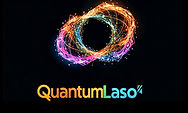From Garage PCs to Quantum Drug Discovery: My Journey Into the Molecular Frontier
- mansour ansari

- Oct 12
- 4 min read
By Mansour Ansari — Founder, QuantumLaso LLC

I’ve been really busy these days. Not bad for a retired software engineer who officially hung up his hat back in 2015. I thought I was done — done with late nights computer issues, demanding clients, done with servers humming in the corner, done with chasing big ideas. For a few weeks, I did nothing but clear out the clutter — old PCs, hard drives, tangled power cables, even a few CRT monitors. Then one afternoon, while cleaning out a dusty box, I stumbled upon a “Chemistry for Dummies” book I’d picked up at a garage sale.
That moment changed my life.

The Spark
Reading those first few chapters, I ran into a section on drug discovery — how a single medicine can take 10 to 15 years and billions of dollars to reach patients. It blew my mind. How could something that critical take so long and cost so much? Yet there it was — the reality of synthesizing, testing, and validating compounds through endless cycles before a single one might help someone survive a disease.
It struck me as both tragic and fascinating. I learned that computers now played a big role in this process. That was my language. I thought, wait a minute — I know computers.
So, this “for dummies” book had just lit a spark under a retired mind that wasn’t quite ready to quit.

The Challenge
I’ve always loved a good challenge — mental or physical. Decades of Olympic weightlifting have taught me that discipline and repetition can move mountains. Every lift, every rep is a promise to yourself that you’ll get a little stronger. Drug discovery felt like the ultimate intellectual lift — not a 200-pound barbell this time, but the weight of chemistry, physics, and code.
At my age, chasing a drug discovery dream felt like entering the Olympics in the 80-kilo class — ambitious, maybe impossible, but that never stopped me before.
Quantum Curiosity
Around that same time, I started reading about quantum computing — “the next big thing,” they called it. I knew that phrase well; that’s what drew me into computing back in the 1980s. I financed my first PC — a heavy beige clone I still have it! — and built software that would later dominate early video streaming markets, long before broadband existed.
Now, decades later, here was another frontier: quantum computing for drug discovery. I didn’t fully understand it at first — how could quantum systems help find cures? But I sensed that randomness itself might hold answers. That intuition proved right.

The Birth of QuantumCURE
I discovered that today, everything needed to build a basic drug discovery engine is out there — free, open, and ready for anyone willing to learn:
RDKit – the Swiss-army knife of molecular modeling.
AutoDock Vina – the docking engine used to test how molecules bind to proteins.
PubChem & PubMed APIs – vast public databases of chemical compounds and biological assays. So, all of these tools can be put to work at zero cost but stitching together a working engine takes massive amount of time. Something I had a lot on my hand!.
And then came the real secret sauce: Quantum Random Number Generators (QRNGs).
Instead of letting a classical computer’s pseudorandom numbers (PRNGs) drive molecular simulations, I began feeding them entropy from a quantum device — genuine randomness from nature itself. It was like plugging raw uncertainty straight into the discovery engine.
Soon, I had a pipeline that harvested quantum seeds, uploaded them to the cloud, and used them to explore deeper regions of chemical space — areas a deterministic algorithm might never reach.

From Garage to Factory
What began as a “garage-quality” experiment quickly grew into a factory-level discovery system — running protein preparation, molecular docking, quantum scoring, and symbolic scaffolding to generate what I call a “Wet-List” — a living database of promising compounds ready for deeper analysis.
Then came the AI integration. Modern machine learning could now sift through millions of docking results, recognize binding patterns, and prioritize candidates with the highest potential.
It was no longer a dream — it was a working system. I called it QuantumCURE. My new hobby!
The Next Leap: Microsoft Skala Integration
The next evolution of QuantumCURE is coming in 2026 (or sooner) with the integration of Microsoft’s Skala, a deep-learning system that brings quantum-level accuracy to Density Functional Theory (DFT) calculations. if you don't understand the Density Functional Theory, that is OK. I don't completely (not yet!) get it myself! but I know how to use the tool and run the AI on my candidate list. You See, the Microsoft AI Skala effectively becomes the final physics-based verifier — confirming binding energies, electron distributions, and molecular stability at near-experimental precision. That is exactly what I need!
This means every compound in the QuantumCURE Wet-List can soon be Skala-verified — bridging the gap between digital discovery and real-world chemistry.
So yes, I’m still that same curious engineer from the ’80s — only now, instead of streaming video, I’m streaming entropy into a molecular universe.
The Journey Continues
One year later, I’ve already simulated over 463,000 compounds, with millions more ahead. I’ve watched patterns emerge, seen affinities improve, and felt the same thrill I once did when my early code first came to life.
People often ask why I’m doing this alone. The answer is simple: because I can. Because modern science has opened its doors to anyone with curiosity, discipline, and access to a bit of computing power.
Who says a solo developer can’t find a cancer drug? Shoot, yeah — I can. And I will. Watch me!
#QuantumCURE #QuantumComputing #DrugDiscovery #AIinScience #MolecularDocking #QuantumEntropy #QuantumBiology #ComputationalChemistry #DFT #Skala #AzureAI #QuantumLaso




Comments